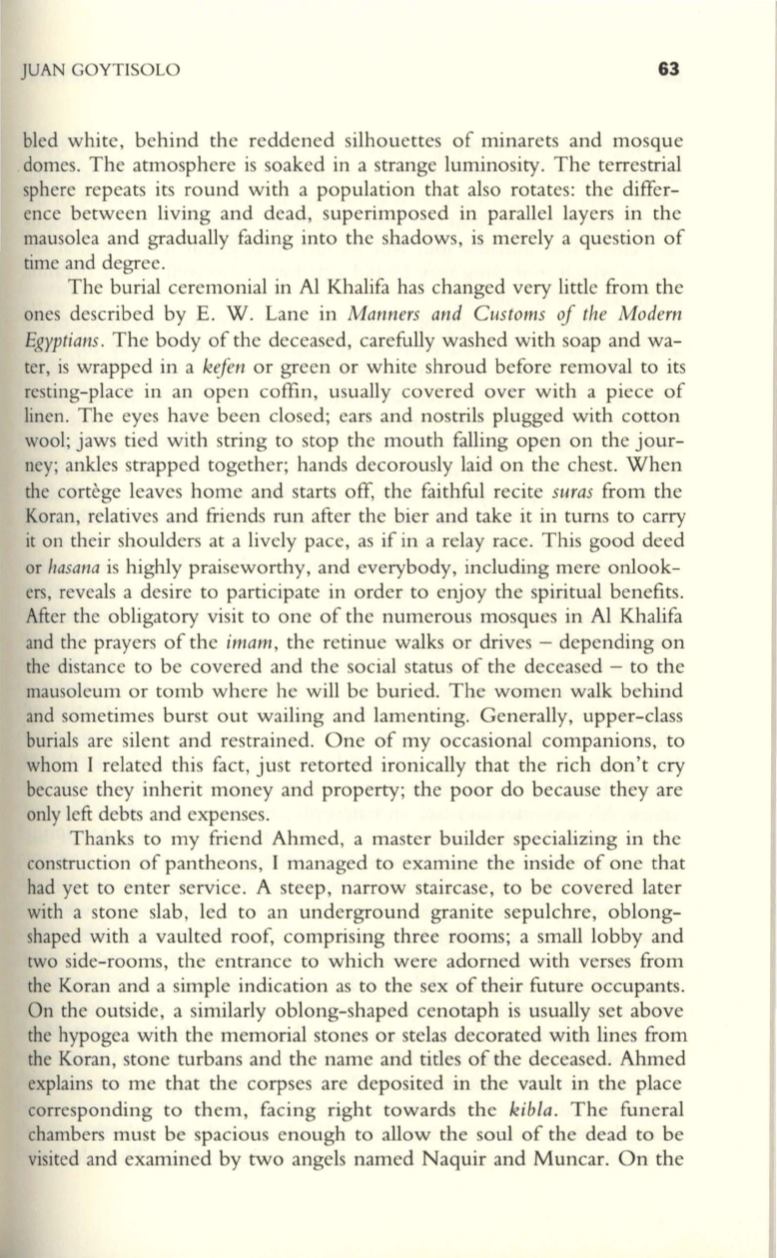
JUAN GOYTlSOLO
63
bled white, behind the reddened silhouettes of minarets and mosque
domes. The atmosphere is soaked in a strange luminosity. The terrestrial
sphere repeats its round with a population that also rotates: the differ–
ence between living and dead, superimposed in parallel layers in the
mausolea and gradually fading into the shadows, is merely a question of
time and degree.
The burial ceremonial in AI Khalifa has changed very little from the
ones described by E. W. Lane in
Manners and Customs oj the Modern
Egyptians .
The body of the deceased, carefully washed with soap and wa–
ter, is wrapped in a
kifen
or green or white shroud before removal to its
resting-place in an open coffin, usually covered over with a piece of
linen. The eyes have been closed; ears and nostrils plugged with cotton
wool; jaws tied with string to stop the mouth falling open on the jour–
ney; ankles strapped together; hands decorously laid on the chest. When
the cortege leaves home and starts off, the faithful recite
suras
from the
Koran, relatives and friends run after the bier and take it in turns to carry
it on their shoulders at a lively pace, as if in a relay race. This good deed
or
hasana
is highly praiseworthy, and everybody, including mere onlook–
ers, reveals a desire to participate in order to enjoy the spiritual benefits.
After the obligatory visit to one of the numerous mosques in AI Khalifa
and the prayers of the
imam,
the retinue walks or drives - depending on
the distance to be covered and the social status of the deceased - to the
mausoleum or tomb where he will be buried. The women walk behind
and sometimes burst out wailing and lamenting. Generally, upper-class
burials are silent and restrained. One of my occasional companions, to
whom I related this fact, just retorted ironically that the rich don't cry
because they inherit money and property; the poor do because they are
only left debts and expenses.
Thanks to my friend Ahmed, a master builder specializing in the
construction of pantheons, I managed to examine the inside of one that
had yet to enter service. A steep, narrow staircase, to be covered later
with a stone slab, led to an underground granite sepulchre, oblong–
shaped with a vaulted roof, comprising three rooms; a small lobby and
two side- rooms, the entrance to which were adorned with verses from
the Koran and a simple indication as to the sex of their future occupants.
On the outside, a similarly oblong-shaped cenotaph is usually set above
the hypogea with the memorial stones or stelas decorated with lines from
the Koran, stone turbans and the name and titles of the deceased. Ahmed
explains to me that the corpses are deposited in the vault in the place
corresponding to them, facing right towards the
kibla.
The funeral
chambers must be spacious enough to allow the soul of the dead to be
visited and examined by two angels named Naquir and Muncar. On the


